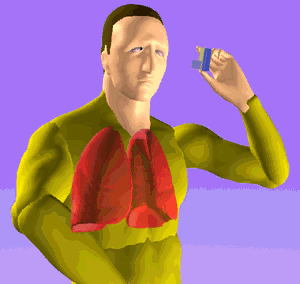Asthma (Respiratory system disease characterized by longing and difficult breathing)

Asthma is a chronic lung disease that inflames and narrows the airways. Chronic illnesses are diseases that last a long time. Asthma causes repeated periods of wheezing, chest tightness, shortness of breath, and coughing. Coughing often occurs at night or in the early morning.
Asthma affects people of all ages, but usually begins in childhood. There are more than 25 million people in the United States with proven asthma. About 7 million of these people are children.
Understanding asthma requires knowing how the airways work. Airways are tubes that carry air in and out of the lungs. In people with asthma, the airways are inflamed (inflated). This makes them very sensitive and tends to react strongly to inhalation of certain substances.
When the airways react, the muscles around them contract. This narrows them down and causes less air to reach the lungs. The swelling may also get worse and narrow the airways further. Airway cells can produce more mucus than usual. Mucus is a thick, sticky fluid that can further narrow the airways.
This chain reaction can cause asthma symptoms. Symptoms may occur each time the airways become inflamed.
Fun fact: Asthma has no cure. Even if you feel fine, you still have the disease and could get worse at any time.
However, because of our current knowledge and treatments, most people with asthma can manage the disease. They may have few or no symptoms. They can live a normal, active life and sleep through the night without interruptions caused by asthma.
If you have asthma, you can actively participate in managing the disease. If you want successful, complete and consistent treatment, form a strong team with your doctor and other health care professionals.
Symptoms
The three most common symptoms in patients with asthma are wheezing (chest whistling with breathing), coughing, and shortness of breath (feeling of choking). These symptoms usually occur simultaneously, although the absence of one or even two of them does not rule out the diagnosis of this disease. Asthma often manifests itself as a single symptom, for example, persistent irritative cough. It is characteristic that asthma symptoms occur episodically and at any time of day, although it is common for them to appear predominantly at night and in the early morning hours. In a minority of patients, symptoms may occur continuously because inflammation and morphological changes of the airways can cause fixed obstruction to airflow. Asthma is not a curable disease at this time, but although it is a chronic disease, symptoms may go away for very long periods of time, even for life.
Causes asthma
The exact cause of asthma is not known. Researchers believe that certain genetic and environmental factors interact to cause asthma, usually in the early years of life. These factors are:
- An inherited tendency to have allergies, called atopia
- Presence of asthma in the parent
- Certain respiratory infections in childhood
- Contact with airborne allergens or exposure to some viral infections in the first few months or years of life, when the immune system is developing
If your family has asthma or atopia, exposure to irritants (such as tobacco smoke) may make your airways react more strongly to substances in the air.
Some factors are more likely to cause asthma in some people than others. Researchers are still trying to find out what causes asthma.
treatments and aids for asthma
Asthma is a chronic disease that has no cure. Chronic illnesses are diseases that last a long time. The goal of treatment is to control the disease. Good asthma control will do the following:
Prevent chronic and bothersome symptoms, such as coughing and shortness of breath
Decrease the need to use quick-relief medicines (see below)
Help keep your lungs functioning well
Allow you to maintain your normal level of activity and sleep through the night
Prevent asthma attacks that could result in an emergency room visit or hospitalization
Work actively with your doctor to manage your child's asthma or asthma. Children 10 years of age or older-and the youngest if they can-are to be actively involved in caring for their illness.
Actively participating in asthma control involves the following:
Work with your doctor to treat other health problems that may interfere with asthma control.
Avoid things that make your asthma worse (the triggers of asthma). However, one of these factors that should not be avoided is physical activity. Physical activity is an important component of a healthy lifestyle. Ask your doctor about medicines to help you stay active.
Collaborate with your doctor and other health professionals to create and follow an asthma action plan.
An asthma action plan helps guide you to take your medicines correctly, avoid asthma triggers (except physical activity), know how well the disease is controlled, respond when symptoms worsen, and seek emergency medical attention when needed.
Asthma is treated with two types of medicines: long-term control medicines and quick-relief medicines. Long-term control medications serve to decrease airway inflammation and prevent asthma symptoms. Quick-relief or "rescue" medicines relieve asthma symptoms that appear.
Initial treatment will depend on the severity of your illness. Follow-up treatment will depend on how well the action plan is controlling symptoms and preventing asthma attacks.
The degree of asthma control can vary over time and depend on changes in the environment at home, school, or work. These changes can alter how often you are exposed to the factors that make your asthma worse.
Your doctor may need to increase the dose of medicine if your asthma is not controlled. However, if the disease is well controlled for several months, it may decrease the dose of the medicine. These medication adjustments will help you keep as much control as possible with the least amount of medication needed.
Treatment of asthma in certain groups-such as children, pregnant women, or people in whom exercise causes asthma symptoms-must be adjusted to meet the patient's needs.
Follow the asthma action plan
You can work with your doctor to create an asthma action plan for you. The plan will describe daily treatments, such as what medicines you need and when to take them. It will also explain when to call a doctor or go to the emergency room.
If your child has asthma, all caregivers should be aware of the action plan. This includes babysitters and people who work in the daycare center, school or camp where the child attends. These people can help your child follow the action plan.
The National Heart, Lung and Blood Institute (NHLBI) has an example asthma control action plan on its website.
Avoid things that can make your asthma worse
Many common things can cause or worsen asthma symptoms. These things are known as triggers for asthma. As soon as you know what they are, you can take steps to control many of them. For more information on asthma triggers, see "What are the signs and symptoms of asthma?
For example, exposure to pollen or air pollution can make your asthma worse. If so, try to limit the amount of time you spend outdoors when there are high concentrations of these substances. If animal fur causes asthma symptoms, have no pets in your home or room.
One of the possible triggers for asthma that should not be avoided is physical activity. Physical activity is an important component of a healthy lifestyle. Ask your doctor about medicines to help you stay active.
 " />
" />Source gif
How it is diagnosed
n order to establish a diagnosis of asthma, certain criteria must be met. The most important is to show at some point that there is reversible obstruction of the bronchial tubes, which is demonstrated by a spirometry that can measure the speed at which a person expels air (airflow). If there is reversible obstruction, the airflow will be reduced and normalized, at least partially, after the administration of a bronchodilator. The main difference with emphysema or chronic bronchitis caused by tobacco is that in these cases the obstruction to airflow is not reversible. Since asthma is an episodic disease, it is very common for a patient to see a doctor when he or she is well and respiratory tests do not reflect the obstruction. However, if the physician suspects that the referred symptoms are due to asthma, the diagnosis can be made by bronchoprovocation tests, which consist of causing bronchospasm with the consequent obstruction of airflow by irritating stimuli of the mucous membrane of the bronchial tubes. There are two types of evidence: Exercise bronchoprovocation by effort is indicated in patients who have asthma symptoms after exercise. The test consists of making a large effort for about 8 minutes, after which spirometry is performed every 10 minutes. In patients with stress-induced asthma, a progressive obstruction of the bronchial tubes can be observed. Once a threshold has been reached (minimum degree of stimulation that produces a sensation), bronchodilator is administered, producing a normalization of spirometry. Typically, patients with stress-induced asthma often refer to symptoms induced by cold air as well. In fact, some pulmonary function laboratories may perform a cold air inhalation bronchoprovocation test. By inhalation of irritants They serve to unmask asthma in patients with any type of asthma (allergic or not). They consist of inhaling a nebulized substance in increasing doses with spirometry after each dose. The irritants used (metacholine and histamine) produce a non-specific reaction and, at high doses, may induce bronchospasm in people without asthma. Induction of bronchospasm with low doses of these substances suggests the diagnosis of asthma. Specific allergen-specific bronchoprovocation tests may be performed in some specialized laboratories. These tests are useful for people who have symptoms after coming into contact with certain environments (working or other) and allow to determine which product produces bronchospasm.
Source information



)
This is a very detailed and good explanation of Asthma and what the classic symptoms are. Having lived with and been around people this illness, I know that not everyone presents the same symptoms.
Always make sure to carry your inhalers with you, specially your blue reliever inhaler.